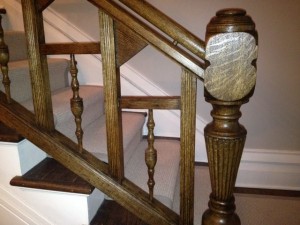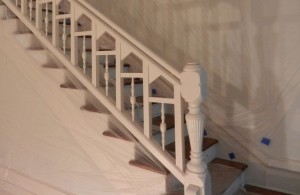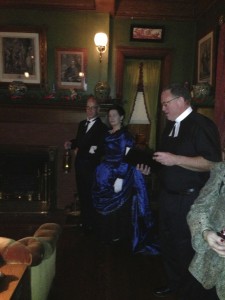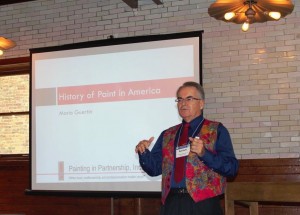Wood refinishing is one of our specialties as house painting contractors in the Chicago area. Starting in the mid-1930’s, it became fashionable to paint woodwork, in spite of the fact the wood may have been oak, cherry, walnut or even mahogany. Over the years, the accumulation of paint layers obscured and sometime obliterated the fine carving detail. In this blog post, I will tell you the happy story of the stripping and restoration of a three-story oak banister in a residence on Chicago’s Gold Coast area.
As a painting and decorating company, we are blessed with having clients who consider their role as homeowners to be “custodians of their piece of history”. The client in this particular story fits that description exactly. The client had purchased this vintage residence earlier last year and embarked on a major renovation of the house. They had a clear concern for having the work done in way that preserved the integrity of the house and flattered its architectural features. One of those features was the banister for the three-story staircase in the center of the house. The wood had been coated in multiple layers of oil-based paint and the clients were dreaming of restoring the original beauty of their banister.
Before launching into this project, they asked their builder to strip a small section to see what kind of wood was underneath. When it was determined that it was oak, the client was sold: strip it all and refinish the banister! Since the wood had originally been stained and varnished, the stripping process completely removed all trace of the paint. Still, much elbow grease was required to accomplish that result. The next step was to come up with a stain color that closely matched the newly refinished oak floor. The final result speaks for itself! Our client has received many enthusiastic comments from neighbors who lauded the new look of the banisters.
Having successfully completed our clients’ wood refinishing project, we will be doing the paint restoration to the metal surfaces on the façade of their building in the springtime. Another example of their “custodial view” is this anecdote. I informed them that the slate roof over the front bay window had previously been painted to match the color of the metal surfaces. When I asked them if they wanted to have the old paint removed to expose the original slate color, the answer was yes! We feel privileged to be part of the process of preserving and restoring the beauty of old buildings in the Chicago area!









 Follow
Follow





